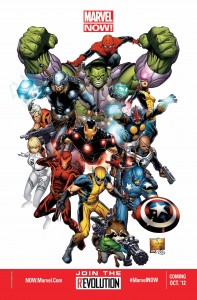Tabula Rasa: The Do’s and Don’ts of the Reboot/Retcon by Jerry Whitworth
Whether it’s a complete clean slate where creators are given the tools to reinvent a universe as they see fit or a soft nudge to make characters carry the appearance of timelessness, reboots and retcons in some form or another are part of the reality of the comic book industry. While there are advocates for allowing characters to grow, age, and move on, the general consensus of comic books since the start of the Silver Age is that characters should be relatively frozen in amber, where their stories continue on but they more-than-not remain within the same framework they’ve always been. Even a character like Spider-Man who went from a high school student to a college graduate and teacher has remained in some manner unchanged, where his life is different yet he still crawls walls at night, battles the likes of the Vulture and Doctor Octopus across the big apple’s skyline, and still copes with what he views as the worst luck in the world (a popular term for this by Stan Lee is “the illusion of change”). In keeping with the Spider-Man example, Marvel Editor-in-Chief Joe Quesada often championed for Spider-Man to revert back somewhat to basics under the idea that his evolution deprives this and future generations of the stories of the character from what many view as his best years (resulting in the reboot One More Day), which is the main argument for characters to remain perpetually static. More famously, DC Comics is known for the reboot Crisis on Infinite Earths where various Earths that represented different eras, franchises, and concepts over several decades were mashed into a single Earth (franchises like the Justice Society, Justice League, Marvel Family, Freedom Fighters, and Captain Atom went from distinct, separate settings to sharing one). Issues resulting from this event would arise and result in subsequent fixes, such as Zero Hour: Crisis in Time, Infinite Crisis, and Flashpoint. Marvel Comics will be treading similar ground for its upcoming Marvel NOW! company wide reboot.
The Golden Rule with a reboot is rather simple: if you’re going to go through the trouble of rebooting something, do it right. If you’re going to reboot Batman only to change that he didn’t catch Joe Chill, you wasted an opportunity. A lot of people like to point to reboots to wipe away stories they don’t like, but we should all keep in mind one person’s trash is another’s treasure. If you want to reboot something, make it richer, grander, better than it was. Don’t get on your soapbox and start tearing apart another writer’s work but instead see where there are logical fits in a story and put them into place. A good example is Batman Begins where Batman’s origin is directly linked to Ra’s al Ghul, which takes the mentor figure Ra’s tried to be for much of his relationship with Batman in the comics (when he wasn’t trying to kill him for defying his wishes) and fit it into place to strengthen the pair’s bond which really ties together Batman and one of his greatest enemies. Something similar is the retroactive reveal of the Joker as Red Hood in the comics, making his origin tie in with Batman’s brutal war on crime was brilliant. It took the Joker, who was already undoubtedly Batman’s greatest foe, and really gave the pair a greater connection (Doctor Doom’s origin also retroactively provided the same treatment when his appearance took off with readers and he was imagined as being Reed Richards’ collegiate rival), intertwining them in a rich tapestry (something similar was done with the Penguin in Batman: Arkham City tying him to Bruce Wayne). Another brilliant re-invention was for Superman: The Animated Series where Brainiac’s origins lie in Krypton and it was his refutation of Jor-El that led to the virtual demise of Superman’s race. This act elevated Brainiac from being a number two to Lex Luthor in terms of Superman’s nemesis and at the very least made his notoriety equal (if not creeping past Luthor in this context).
Perhaps one of the greatest mistakes a reboot can make is firmly planting a character in a specific time period such as aligning with the present of the publication. Consider the Justice Society of America, whose members were notably combatants of the Axis Powers. In doing this, the characters have to be firmly planted in World War II. If you try to bring its members into the present, then you begin patching holes in how they can possibly be active in a present some seventy years later (unless, of course, you’re the Spectre). Logically, along these lines, members of Infinity, Inc would likely be older than members of the present day Justice League! It’s as bad as saying Superman appeared around the 9/11 tragedy or Captain America premiered during the first Iraq war and then begin to watch that clock tick away all over again. Consider many comics during the 1970s where its characters were speaking jive in some silly attempt to make the cast relatable to youth. Instead, tell a story that relates to the struggles of youth regardless of the time period and kids will “get it.” Stories should be less about characters talking about Twilight, the latest game on some console, or referencing a tweet or post and instead be about timeless elements like standing up to authority when its wrong, battling the temptation of peer pressure, and juggling responsibilities that people have faced since the dawn of civilization. This isn’t to say we shouldn’t have characters use cell phones, social media, etc, but try not to firmly plant a character in a specific time period as a major plot point unless you plan to defy convention and age a character (unless, of course, it will mean a really good story like Richard Donner’s plan for reinventing Brainiac in Action Comics as a quasi-sophisticated alien virus, along the lines of how he reportedly was going to introduce him in the third Superman film, that was shelved which readers will forgive for being awesome). A good example of a timeless story is V for Vendetta which approached elements that repeat throughout history (when the film adaptation premiered, for example, the media perceived it as an analogy for the George W. Bush administration), albeit borrowing elements of Brave New World and Nineteen Eighty-Four.
If you’re going to rewrite history for a character, put up front what worked best for the story and push that element forward. A good example is the work Greg Weisman has done with comic book animated adaptations like Spectacular Spider-Man and Young Justice. For Spectacular, instead of following the comics where Peter meets Flash Thompson and Liz Allan in high school and then moves on to meet the likes of Gwen Stacy, Harry Osborn, Mary Jane Watson, Eddie Brock, and more through the years, they were all planted during what many consider Spider-Man’s best years as a teenager. And instead of random bad guys just happening to appear after the appearance of Spider-Man (and later explained that it had something to do with magic totems), tie the villains in with Spider-Man’s worst enemies in Norman Osborn, Dr. Octopus, and Tombstone (standing in for the Kingpin, who was tied in with the Daredevil franchise, as the Big Man) as crooks given powers to deal with the emerging hero who was hitting organized crime deeply in its pockets (similar to the concept of escalation in the Nolan Batman films). In a similar manner, Young Justice features likely the most notable sidekicks in DC Comics’ rich history as their separate chronologies are realigned to coincide with each other, essentially forming the greatest incarnation of the Teen Titans/Young Justice possible. But the good guys aren’t alone in star treatment as the villains in the Light essentially mash together the Secret Society of Super-Villains with the pre-Infinite Crisis Society adding a dash of Marvel’s popular Cabal concept posing one of the most dire threats in any variation of the Justice League. In many ways, you could look to Weisman and his work for how to properly perform a reboot.
Now, if there is one sin that can be made with doing a reboot, it’s likely changing a character to suit your purpose. Lets face it, Superman came to Earth on a rocket from Krypton, Batman’s parents were slain motivating him to become a hero, and Spider-Man let a Burglar go only to see his Uncle Ben murdered by that same criminal. When you start mucking with these concepts, you’re not only messing around with the elements that brought a character to the show, you’re pissing on decades on stories built from the bedrock of these ideas. For that matter, when Superman becomes a mindless dolt who does whatever the POTUS tells him to do, Batman runs for mayor or dances the Batusi at a night club, or Spider-Man slaps on an Iron Spidey suit and starts locking up heroes and friends for the government, you’re again taking an idea beloved by millions and perverting it for your own ends (if it’s an Elseworlds or What If?, though, have at it, go crazy). The second Dr. Doom starts talking like A Pimp Named Slickback, you’ve broken the illusion and taken your audience out of the experience. I’ve often heard the case made that a writer is chained to years of continuity for these characters, but would you expect a brain surgeon to operate without practice or a nuclear scientist to build a uranium-enriched reactor without having passed high school Physics? Don’t get me wrong, I don’t expect a writer to know every story a character was involved in, a somewhat moot point when dealing with a reboot, but it’s a writer’s job to understand a character’s voice and motivations. In other words, even if you’re compelled to set the clock back on a character, so far to wipe out virtually every story of their history, you at least should keep their origin and personality intact. No one wants to see a vengeful Captain Marvel (DC Comics), remorseful Punisher, or Wolverine as everyone’s buddy.
This article idea was submitted by Janson Olson.







